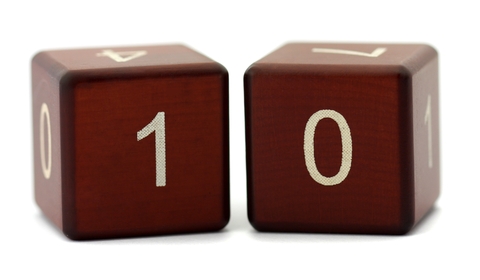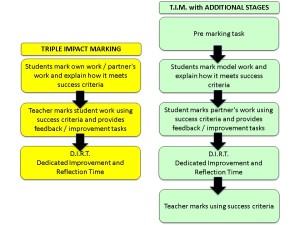“A smooth sea never made a skillful sailor” – English proverb
Our fourth Magic Monday 2 presentation was another cross-curricular effort from Simon Thompson, our Assistant Head of MFL and Michael Caygill from our Science department.
Simon began by sharing with us how he has developed the Triple Impact Marking strategy used by David Didau here further to include some additional stages.
Triple Impact Marking:
(1) Students peer / self-assess using the success criteria
(2) Teacher assesses – point out errors / ask questions / sets improvement tasks
(3) D.I.R.T. (Dedicated Improvement Reflection Time) – students respond to feedback / complete improvements
Additional stages:
Prior to stage (1) above, Simon sets his students a pre-task to help them see how their work can be improved even further. The pre-task is designed to engage students with the success criteria at the higher end. In the following example, students are asked to find linking words, opinions and justifications.
Students then assess a pre-prepared piece of writing using the success criteria, justifying their reasons for the final grade awarded.
Following this they peer-assess their partner’s work using the success criteria and make suggestions for any final improvements.
Students then redraft their own work, completing improvements during D.I.R.T.
Comparing the two processes:
The key similarities and differences between the two processes are shown below.
What has been the impact?
- Peer assessment has allowed students to engage in positive, constructive feedback regarding their work.
- Giving the students the chance to redraft their work has allowed for a much-improved quality of work to mark.
- In subsequent work students have begun to incorporate the most desirable features into their work, e.g. linking words, opinions and reasons without it being suggested as they begin to appreciate success criteria.
Continuing in the same theme, Michael began by sharing how he too uses examples of work with students, which they then improve – for example, this piece of work where students had to improve a scientific method by first being clear about the variables and how they were controlled.
We then heard how Michael uses simple highlighting and SOLO levels to identify specific sections of work that need to be redrafted in order to make progress rather than the whole piece of work.
This can take the form of merely highlighting a section and then asking students to use the success criteria to identify their own areas for improvement, or to compare their work with another student who has already met the criteria for their highlighted section.
Specific guidance can then be given after any improvements in the form of:
- What’s Good and Why
- Even Better If
…which the students then respond to by improving their work, thus closing the gap.
To support the redrafting process, Michael has encouraged his students to embrace the concept of First Attempt In Learning………….or F.A.I.L.
Again, by ensuring that quality feedback linked to clear success criteria are provided prior to their Second Attempt In Learning…………….or S.A.I.L. the gap can be closed.
Another way that Michael has promoted the concept of moving from F.A.I.L. to S.A.I.L. has been to make it explicit in the resources he creates for his students.
He has also extended this idea further to incorporate an additional stage where, following their F.A.I.L. students record and analyse their peers’ ideas prior to feeding back and completing their S.A.I.L.
Using the cycle of learning and feedback shared by Tom Sherrington in his post here from Saffron Walden County High School as a basis, we can model this process as:
By creating a culture of F.A.I.L. the possible advantages to such a process appear obvious:
- students have more reason to engage explicitly with the success criteria and subsequent feedback from their teacher or peers
- closing the gap becomes an explicit and in-built part of the learning cycle
- students produce work of a superior quality
- teacher workload can be reduced
- the impact of feedback is increased
……….perhaps it’s time we all set sail?













Pingback: Too Long away EduTECH the most important week of my teaching career. | macbook implementation
Pingback: Assessment | PGCEPhysicalEducation